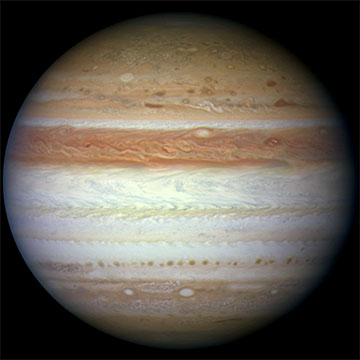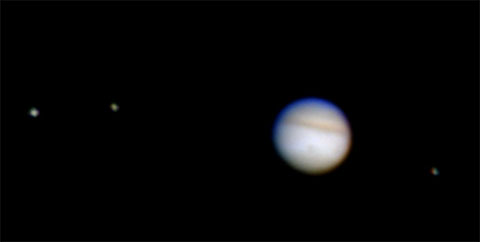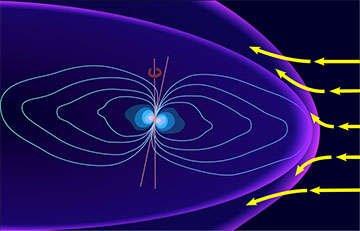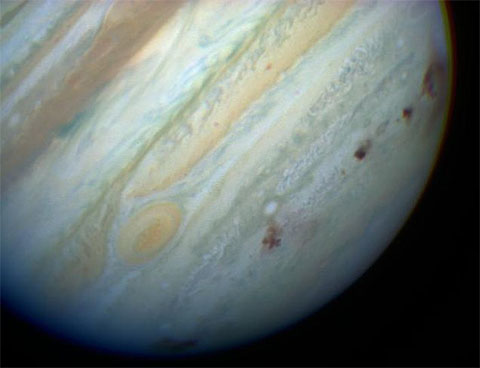

| Archive Blog Cast Forum RSS Books! Poll Results About Search Fan Art Podcast More Stuff Random |
|
Classic comic reruns every day
|
1 {photo of Jupiter from the Cassini-Huygens probe mission}
1 Caption: King of the Planets
|
First (1) | Previous (3268) | Next (3270) || Latest Rerun (2895) |
Latest New (5380) First 5 | Previous 5 | Next 5 | Latest 5 Annotations theme: First | Previous | Next | Latest || First 5 | Previous 5 | Next 5 | Latest 5 This strip's permanent URL: http://www.irregularwebcomic.net/3269.html
Annotations off: turn on
Annotations on: turn off
|
 Fragments of Comet Shoemaker-Levy 9, imaged by NASA's Hubble Space Telescope. Public domain image from Wikimedia Commons. |
Comet Shoemaker-Levy 9 was discovered by experienced comet hunters Carolyn and Eugene Shoemaker and David Levy in 1993. It was an extremely unusual comet for several reasons. Firstly, it wasn't orbiting our sun. Comets originate deep in the outskirts of our solar system, beyond the realm of the planets, in the Oort Cloud, where billions of chunks of ice waltz slowly about our sun. Some accumulate enough of a gravitational disturbance over time that they begin plunging in towards the sun. They briefly flare up, creating a gigantic tail of gas and dust, round the sun, then return whence they came, never to be seen again.
Occasionally, on its passage through the inner solar system, a comet is perturbed in its path by the gravitational tug of one of the planets. Such a comet may end up on an elliptical orbit, and return to the inner solar system periodically. Halley's Comet is one of these, returning every 76 years. Comets which pass thorough the crowded inner solar system many times can end up having their orbits further perturbed by the gravitational forces of the planets. Some have their orbits altered further, into shorter periods. And for some, something even more dramatic happens.
 Jupiter, imaged by NASA's Hubble Space Telescope. Public domain image from Wikimedia Commons. |
Jupiter lies beyond Mars, the next planet out from our sun. The gap between Mars and Jupiter is significant because it represents a natural boundary in the solar system. When the planets formed, the infant sun heated the material accreting around it, and the wind of particles streaming outward from its surface carried away any loose gas that got caught up in the flow. The growing blobs of matter that would become the planets could hold on to certain elements, but only the ones that were held down by gravity or molecular forces. In the innermost regions of the solar system—where Mercury, Venus, Earth, and Mars formed—the lightest elements were vaporised and blown away by the solar wind. Beyond Mars, something else happened. These volatile elements formed frozen compounds that withstood the blasting of the sun. This meant they could collect and gather into larger lumps and eventually coalesce into planets. The universe is made mostly of hydrogen and helium, so by keeping these elements, the planets out here could grow much, much bigger than the ones closer to the sun. They grew large enough that they could begin holding on to gaseous hydrogen and helium by their gravity (something our Earth cannot do). This region became the realm of the gas giant planets, and the largest of all became the planet we know as Jupiter.
Like the other planets, Jupiter is named for a Roman god. In this case, it is the king of the gods (also known as Jove and identified with Zeus of the Greek mythology). And the name turned out to be appropriate as Jupiter is the largest planet, which accounts for its massive gravitational influence. Also like the other planets, Jupiter has cultural associations which continue to the present day. In many European languages, the name for Thursday derives from "Jove": giovedi in Italian, jueves in Spanish, jeudi in French. (Our own Thursday in English comes from the Nordic Thor.) And something I haven't mentioned before in this series on the planets: The planets have an associated adjective which describe human temperaments. You can be mercurial (flighty and fickle, like the swift-moving Mercury), martial (aggressive and military, like the planet named for the god of war), or jovial (jolly and merry like the king of gods). Or... hmmm... venereal.[1]
 Movement of storms on Jupiter, imaged by NASA's Hubble Space Telescope. The Great Red Spot is at lower centre. Public domain image from Wikimedia Commons. |
Jupiter's atmosphere is very deep. The atmosphere of our Earth is exceptionally thin. Go up a mere four kilometres (a distance you could walk horizontally in less than an hour) and you will start to feel short of breath and struggle to engage in any sort of physical activity. Go up another four and you may well die from lack of oxygen. Come back down to sea level and the air will feel soupy and thick in comparison until you readjust. And so it is on Jupiter. The atmosphere (which is mostly hydrogen so you couldn't actually breathe it safely) gets thicker as you go down. And down. And down. Hundreds, thousands of kilometres down. The gas just gets thicker and thicker and thicker, until it feels like you're moving through a liquid—water, honey, treacle, bitumen—and still thicker and thicker. Eventually you won't be able to move at all. But you'll have long ago been crushed to death by the tremendous atmospheric pressure at these depths anyway.
At the centre of this immense, treacly mass of gas is a ball of iron. A ball about the size of Earth. There'll be some other elements mixed in there—silicon and oxygen and so on (these would make up the "rocks", if you want to be generous and call them that)—but it's essentially a ball of iron. Actually, we don't have any direct evidence for the internal structure of Jupiter. All of this is based on physical modelling and our knowledge of the elemental make-up of the solar system in general. So while it's likely to be roughly correct, there may be some surprising details. If we ever manage to probe the interior of Jupiter directly, that is, which seems highly unlikely with our present understanding of technology.
 Jupiter and three Galilean moons, seen through a small telescope. Creative Commons Attribution image by Thomas Bresson. |
The first major discovery about Jupiter wasn't even about the planet itself. Galileo Galilei turned his first crude telescope to the planet in 1610 and was astonished to see that it was accompanied by four smaller points of light. Over time, he saw that they were moving around the planet. They were moons—bodies moving around a planet rather than around the sun—and the first moons discovered after our own familiar moon. This may seem more trivial today, but in Galileo's time it caused a sensation. Here was the first concrete proof that not everything in the universe moved around the Earth. Some people refused to accept the evidence, but in the end Galileo was proved right in his support for Copernicus's heliocentric model of the solar system. Galileo wanted to call the moons Cosimo's Stars after his patron Cosimo II de' Medici, but Cosimo himself suggested naming them the Medician Stars to honour his whole family. Johannes Kepler had a different idea, suggesting to his friend Simon Marius (who also made early observations of the moons) that they be named after mythological lovers of Zeus (the Greek counterpart of Jupiter). Marius liked the idea, suggesting the names Io, Europa, Ganymede, and Callisto. These are the names we use today, and Galileo's suggestion has dropped into obscurity, replaced with the designation of the Galilean moons for the entire group.
 Jupiter's magnetic field. Jupiter is the small orange dot at centre. Yellow arrows show the solar wind. Public domain image from Wikimedia Commons. |
In 1964, aerospace engineer Gary Flandro was working at NASA's Jet Propulsion Laboratory and was given the task of exploring possibilities for trajectories for unmanned probe spacecraft to the outer planets. He discovered something almost as astonishing as Galileo. In the late 1970s, there would be a rare aligment of all of the planets in the outer solar system, which would allow a single spacecraft to visit all of them in sequence, on an efficient trajectory using minimal fuel. He calculated that such an opportunity would not recur for another 175 years. Flandro found backers and pitched a proposal for a Planetary Grand Tour mission which would send a total of four probes to every body from Jupiter out to the known limits of the solar system. Budget cuts reduced the mission considerably, down to the two-probe Voyager program, launched in 1977. But prior to such a risky mission, the engineers at NASA wanted to test the water. The outer solar system was an unknown quantity, and NASA deemed it prudent to send two less sophisticated probes to see what sort of unexpected problems might be encountered out there.
These probes were Pioneer 10 and Pioneer 11, launched in 1972 and 1973, respectively. Pioneer 10 flew past Jupiter in December 1973, and Pioneer 11 followed a year later. The first thing they found was the Jupiter's magnetic field was much stronger and larger than expected. It dominates space out to about 100 times the radius of the planet itself. If you could see Jupiter's magnetic field in our night sky, it would be larger than the moon. It funnelled charged particles into radiation belts around the planet that subjected the Pioneers to unforeseen stresses. Learning of this, NASA engineers quickly redesigned the instruments destined for the Voyager probes, to harden the electronics against being fried by the radiation. Without Pioneer, Voyager would have been a very expensive failure. The Pioneers took the first close up images of Jupiter, revealing structure in the brown stripes that showed them to be intriguing swirling streams of clouds. They also took images of the Galilean moons, but these were poorly placed for good photos and the resulting images were fuzzy and not particularly revealing. Pioneer 10 did take close up images of Io, but these were never transmitted to Earth because of radiation damage to the probe.
 Voyager 1 image of Io in which volcanic eruption was first seen. Public domain image from Wikimedia Commons. |
The Voyager mission was quickly reconfigured to give more focus to Jupiter's moons, and it was a good thing too. For the moons turned out to provide the most surprising and dramatic discoveries of the Jupiter encounters. But perhaps we should talk more about those in detail some other time.
The Voyagers also discovered several smaller moons, and a thin set of rings around Jupiter, like those of Saturn, only much thinner and fainter, so they had never been detected from Earth. And they did spectroscopic studies of the atmosphere, which helped determine its chemical composition. Our knowledge about Jupiter's atmosphere was greatly increased by the later Galileo mission, which dropped an entry probe into the planet in December 1995. The probe descended through over 150 kilometres of atmosphere in just under an hour before it failed under the intense pressure and heat, returning loads of data about the atmospheric composition and turbulence. Unfortunately, the Galileo probe happened to descend in a small gap between the clouds, so our knowledge about those is still rudimentary. Besides hydrogen and helium, Jupiter's atmosphere contains simple compounds including water, ammonia, methane, and hydrogen sulphide, although in very small amounts. There are also traces of hydrocarbons, which raises the possibility of simple organic molecules. These, and perhaps compounds of phosphorus or sulphur, may be what gives the clouds their range of reddish brown colours. We don't know for sure yet.
 Aftermath of Shoemaker-Levy 9 impacts with Jupiter. Dark brown spots mark the impact sites. Public domain image from Wikimedia Commons. |
With the good fortune of having time to prepare, hundreds of telescopes, optical and radio, as well as space-based infrared and ultraviolet telescopes, were trained on Jupiter in July 1994. The impacts as the chunks of comet plunged into the planet over several days were dramatic, causing huge fireballs and stirring up the cloud layers to leave dark scars on the planet. The churning of the atmosphere and the heating to a white hot glow gave astronomers the chance to spectroscopically study parts of Jupiter's atmosphere normally hidden. This allowed the direct detection of sulphur, and also presented a surprise. Astronomers expected to see oxygen compounds, but none were detected. There was also less water than expected. Over the next few months, the impact scars faded as Jupiter's atmospheric circulation dissipated them.
We thought that Comet Shoemaker-Levy 9 was a once-in-a-lifetime event, which we were fortunate to have experienced in the modern age when we had the telescopes and advanced instrumentation available to study it. But in 2009, an amateur astronomer named Anthony Wesley was looking at images of Jupiter taken from his home observatory in the small town of Murrumbateman, near Canberra in Australia. He saw something odd - a strange dark spot on Jupiter. It was so unusual that he sent an e-mail to NASA's Jet Propulsion Laboratory. The news spread quickly through the astronomical community and Wesley's observations were confirmed by several major observatories. What they were looking at was an impact scar similar to those seen from the Shoemaker-Levy 9 collisions. Only this time nobody had detected the impacting object before the event. Studies showed that it must have been a relatively large object, probably an asteroid several hundred metres across. (Asteroids are darker and harder to detect than comets.)
And that wasn't all. Just a year later, Wesley found another impact marker on Jupiter. This was much smaller, probably the result of an impactor only a few metres across. Then in 2012, amateur astronomer Dan Peterson recorded a video of a flash of light on Jupiter. There were some claims of a hoax, but astronomers have confirmed the event was real and probably caused by the impact of a small asteroid. These sorts of impact events are not rare at all, but very common. Leftover chunks of planetary formation swarm all over our solar system, and the largest planet of all, Jupiter, exerts a huge gravitational force on them, pulling many of them into death spirals that end with crashing into the planet's immense atmosphere.
If there's something amazing we've learnt from Jupiter in recent years, it's that the era of planetary formation in our solar system is not over. It's merely slowed down a bit since the early days when chunks of rock and ice collided on an hourly basis. The planets are still gobbling up new material as smaller solar system bodies crash into them. And it's not a rare event, it happens all the time. In the future we'll no doubt see many more impacts in the atmosphere of Jupiter. And with each one our knowledge of the planets and our solar system will grow. The king of the planets still has much to teach us.
[2] And possibly the most awesome photobomb in history.
|
LEGO® is a registered trademark of the LEGO Group of companies,
which does not sponsor, authorise, or endorse this site. This material is presented in accordance with the LEGO® Fair Play Guidelines. |